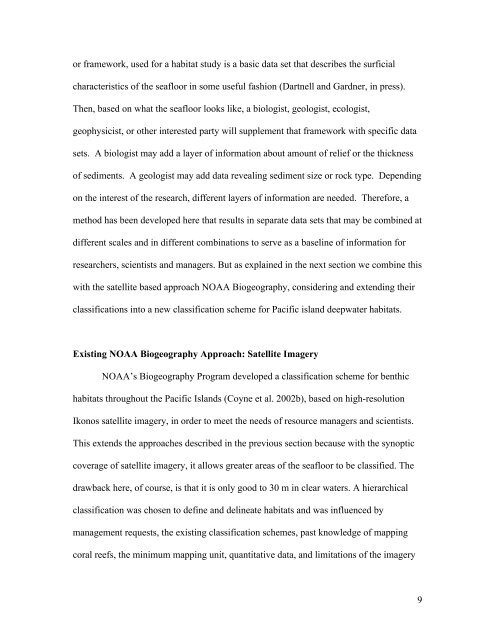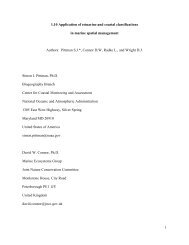A Benthic Terrain Classification Scheme for American Samoa
A Benthic Terrain Classification Scheme for American Samoa
A Benthic Terrain Classification Scheme for American Samoa
You also want an ePaper? Increase the reach of your titles
YUMPU automatically turns print PDFs into web optimized ePapers that Google loves.
or framework, used <strong>for</strong> a habitat study is a basic data set that describes the surficial<br />
characteristics of the seafloor in some useful fashion (Dartnell and Gardner, in press).<br />
Then, based on what the seafloor looks like, a biologist, geologist, ecologist,<br />
geophysicist, or other interested party will supplement that framework with specific data<br />
sets. A biologist may add a layer of in<strong>for</strong>mation about amount of relief or the thickness<br />
of sediments. A geologist may add data revealing sediment size or rock type. Depending<br />
on the interest of the research, different layers of in<strong>for</strong>mation are needed. There<strong>for</strong>e, a<br />
method has been developed here that results in separate data sets that may be combined at<br />
different scales and in different combinations to serve as a baseline of in<strong>for</strong>mation <strong>for</strong><br />
researchers, scientists and managers. But as explained in the next section we combine this<br />
with the satellite based approach NOAA Biogeography, considering and extending their<br />
classifications into a new classification scheme <strong>for</strong> Pacific island deepwater habitats.<br />
Existing NOAA Biogeography Approach: Satellite Imagery<br />
NOAA’s Biogeography Program developed a classification scheme <strong>for</strong> benthic<br />
habitats throughout the Pacific Islands (Coyne et al. 2002b), based on high-resolution<br />
Ikonos satellite imagery, in order to meet the needs of resource managers and scientists.<br />
This extends the approaches described in the previous section because with the synoptic<br />
coverage of satellite imagery, it allows greater areas of the seafloor to be classified. The<br />
drawback here, of course, is that it is only good to 30 m in clear waters. A hierarchical<br />
classification was chosen to define and delineate habitats and was influenced by<br />
management requests, the existing classification schemes, past knowledge of mapping<br />
coral reefs, the minimum mapping unit, quantitative data, and limitations of the imagery<br />
9
















